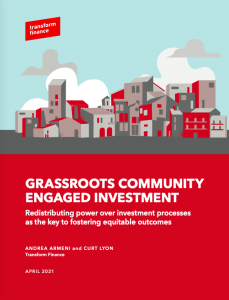Over the past several decades, the fields of community development, community investment, and impact investment have evolved in response to demands from activists and the communities they serve. These capital providers are addressing financing gaps that cause disparities in wealth, jobs, education, and health – especially within Black, Indigenous, and People of Colour (BIPOC) and working-class communities.
 Efforts of mission-driven financial actors have made gains in addressing affordable housing stock, business capital access, and crumbling infrastructure. But the disparities still remain. While under-investment and lack of capital for community needs to be addressed, simply injecting more capital into communities will not ameliorate the existing inequities seen across racial and geographical lines. In order to resolve generational wealth extraction from BIPOC and working-class communities, there needs to be more accountability for investors and funders, and more agency for these communities.
Efforts of mission-driven financial actors have made gains in addressing affordable housing stock, business capital access, and crumbling infrastructure. But the disparities still remain. While under-investment and lack of capital for community needs to be addressed, simply injecting more capital into communities will not ameliorate the existing inequities seen across racial and geographical lines. In order to resolve generational wealth extraction from BIPOC and working-class communities, there needs to be more accountability for investors and funders, and more agency for these communities.
This is not a new concept, but one that is still gaining traction among community development practitioners. Investments that have historically fallen within the purview of community development have been detached from considerations around power and agency, such as outcome goals, performance goals and process goals of the project. In leaving out the direct involvement and leadership of grassroots stakeholders, investments risk failing to meet community needs. Furthermore, investment decisions that are made without grassroots input, feedback loops, or co-governance mechanisms fail to address fundamental gaps of agency and power in communities.
We need to centre the voices of people harmed by systems in changing those systems.
There is a huge opportunity for funders and investors to drive equity through their capital by seeding and supporting projects that have community members and grassroots organisations designing and governing the investment process. We call this Grassroots Community Engaged Investment (GCEI). GCEI builds power by using the process of investment as an arena for grassroots stakeholders to advance their long-term agendas by:
- Bringing in existing social justice movements into conversations around capital where they were previously excluded
- Forging productive connections between grassroots and institutional stakeholders
- Building community knowledge around local finance and economic development ecosystems
- Funding projects that are supported by and reciprocally support existing movements in the community
The power building that emerges from GCEI sets it apart from investments into communities that do not take a GCEI approach.
Our new report, written with support from the Robert Wood Johnson Foundation, is the first attempt to synthesise details of projects around the United States that are implementing GCEI. We interviewed project leaders and supporters to understand the necessary criteria and capital products for their success and determine the greatest needs of the field.
- GCEI is a layer of process that can be implemented across a variety of investment structures and project types. GCEI is seen in business, real estate, and housing investments, with goals that range from democratising an entire local economy to developing the infrastructure to direct capital towards underfunded lenders.
- Building power is the key to long lasting, transformative change in communities. Focusing on wealth building is necessary when investing in communities but is not sufficient on its own. There needs to be a power building component too.
- The strongest GCEI projects have grassroots input starting at the very beginning, including designing the goals of the project. Doing so ensures that the project is structured in a way that addresses the core needs of the community. For projects initiated by outside institutions, governance should be passed to grassroots stakeholders as early as possible so they can advise, revise, and implement the project goal.
- Ongoing governance is critical for grassroots stakeholders to continue to keep the project on track with the priorities of the communities, and to hold non-community institutions who are key partners in implementing the project accountable. It’s possible for outside partners, like Community Development Financial Institutions (CDFIs), to take on financing roles while maintaining that governance.
- GCEI projects require a range of capital, from grants to loans to equity to revenue-based financing. Potential funders and investors need to assess what they can offer and what the community needs before supporting, rather than favouring a specific financial product that might not be the best fit.
- There is good reason to suggest that engagement of grassroots stakeholders leads to unique and powerful outcomes for communities compared to traditional development methods. Community engagement fosters increased civic engagement, strengthens relationships between grassroots organisations and powerful institutions, helps transform those institutions, and unlocks new sources of capital for movement work.
These insights are just some of the many we collected in our report. The report is meant not to call out practitioners, but to invite all stakeholders to consider ways in which investment can best lead to transformative shifts in the conditions for equity. Moving forward, we hope that funders and investment practitioners pay attention and learn from the GCEI efforts that are just now beginning to bear fruit. It will require experimentation and exploration of GCEI as an alternative to conventional investment practices if the community development field is to realise its goals of equity.
For more on the subject, check out the report: Grassroots Community Engaged Investment.
Shante Little supports research efforts and develops content strategies across Transform Finance’s investor-facing programmes as Research and Content Lead. Curt Lyon helps steer the direction and vision of Transform Finance’s programmes and manages major research and advisory projects as Deputy Director.







Comments (0)